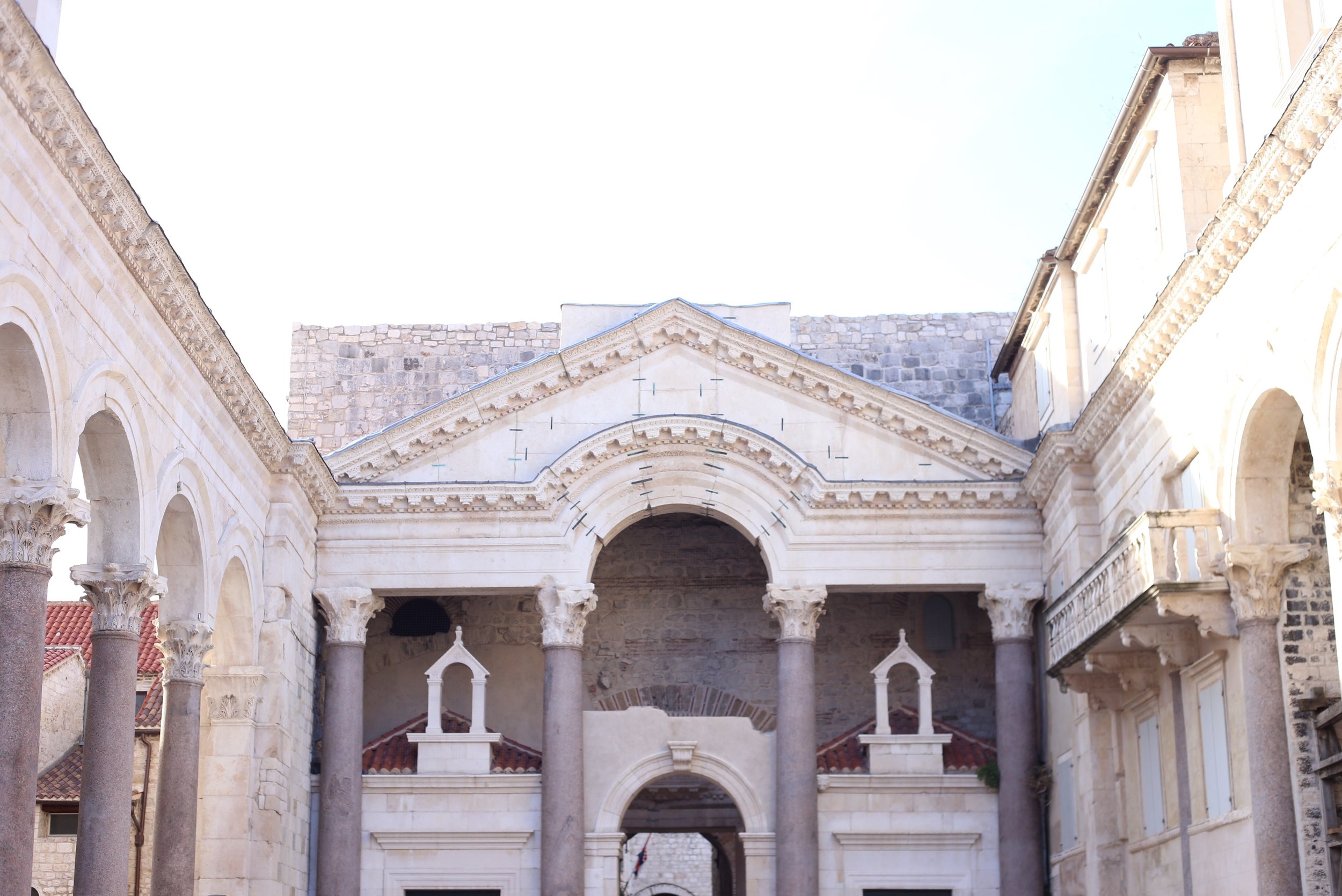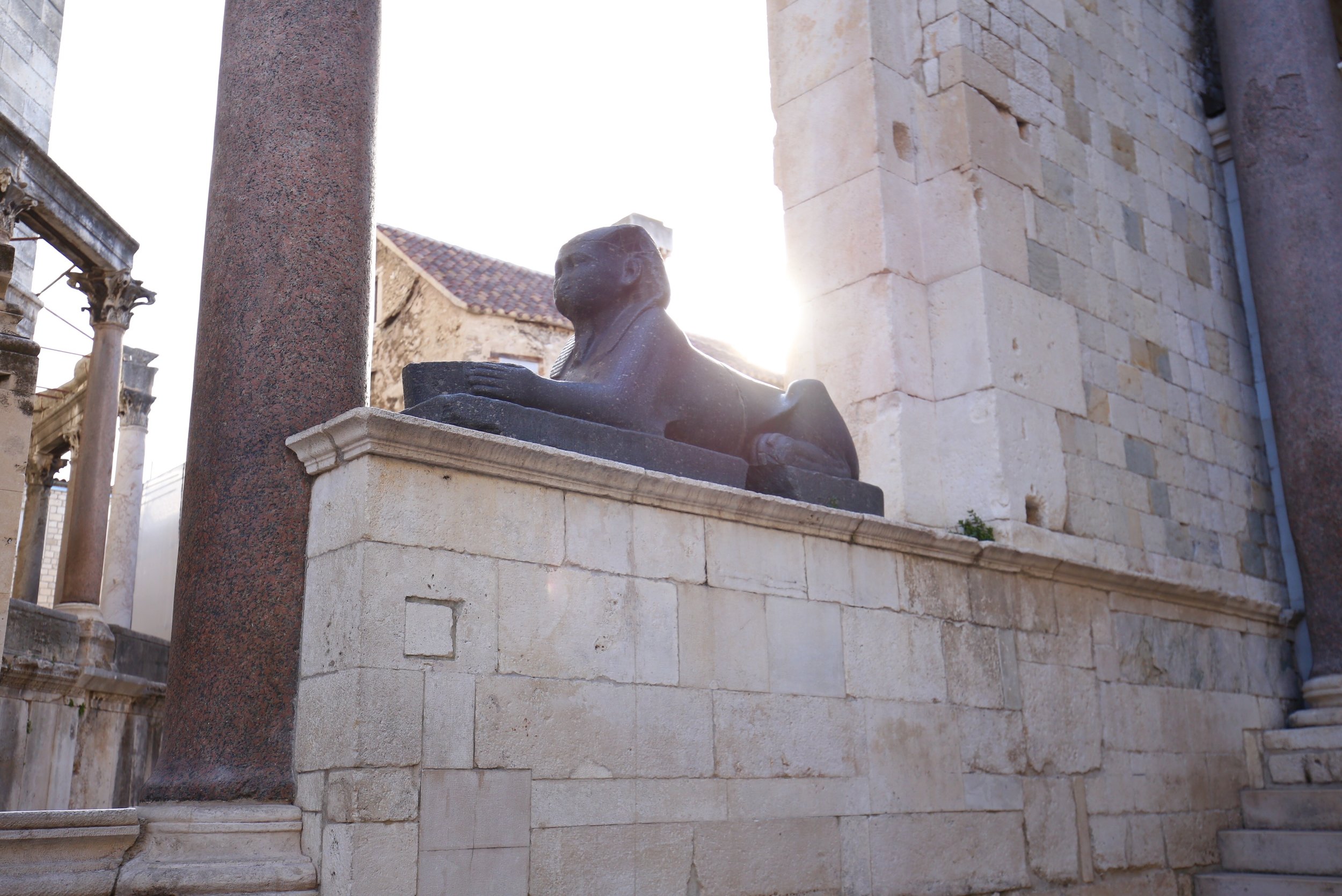OR
... a story in which many rambling thoughts come together to form a whole new idea.
DIOCLETIAN'S PALACE
{ a memory }
We begin our story in the town of Split, on the shores of Croatia. The city is in our sights, and we are a small beam of light that travels through the atmosphere on this sunny, windy day. Now the Old Town is visible, with its warren of walls and hidey-hole apartments. As we descend, we see, at the very centre of the town, a large open space - a light, bright, white space - the perfect place for a light wave such as ourselves to descend into...
But what is this? Our attention is caught by the building next door: in its ceiling is an aperture, a round opening like an eye. Curiosity takes ahold of us, and we zip along through the ether, to take a peek...
Inside is a round, pink, stone room, and on the floor is a girl. Her cheeks are red with the cold, her eyes closed, she seems to be thinking. Outside are the calls of other humans, sounds of life. Inside is quiet. She is somehow more present, and yet more distant, than those in the outer world. Her focus centered, the room is a vessel, she fills it with her presence.
...
ON TEMPLES
{ their nature | in nature }
&
{ our role in their creation }
What is a temple?
I want you to ask yourself this question, let the query sit with you as we delve deeper into the subject. Here, in my world, there are no right or wrong answers - only reflections and contemplations. So, let us begin by asking ourselves: what constitutes a temple?
A temple exists in space and time. Is it an object? A noun? Most of us would presume so.
Not only does a temple exist in space and time, one could argue that it is made of space and time. Humour me for a moment, if you will. How is a temple defined from the space around it? What defines it, where does the boundary lie between "the temple" and "not the temple." In physical and historical terms, the boundary of a temple is set by the walls that surround it. But what of the inner space - how might a few walls cleave the air so as to denote the space contained therein as being of a 'holy' nature, while the outer space remains comparatively mundane? Is it not the same light that illuminates each, and the same air composition, and the same stone in the walls that resides in the ground in the nearby fields? Here we are met with an interesting thought - we are forced to move beyond the confines of the logical, physical world, and into the realms of the mind and of metaphysics.
When a witch draws in a sacred circle, calling in the elements, she is creating a temporary space of a sacred nature, within which to perform her work. Does this circle exist within physical space, or in her mind, or in some other realm?
When building the beautiful cathedral St Denis, the Abbot Suger had this to say about the vast inner space:
“Thus sometimes when, because of my delight in the beauty of the house of God, the multicolor loveliness of the gems has called me away from external cares, and worthy meditation, transporting me from material to immaterial things, has persuaded me to examine the diversity of holy virtues, then I seem to see myself existing on some level, as it were, beyond our earthly one, neither completely in the slime of earth nor completely in the purity of heaven. By the gift of God I can be transported in an anagogical manner from this inferior level to that superior one.”
Nearly a millennium later, one Albert Einstein worked out his theories about space and time:
“Since there exists in this four dimensional structure [space-time] no longer any sections which represent “now” objectively, the concepts of happening and becoming are indeed not completely suspended, but yet complicated. It appears therefore more natural to think of physical reality as a four dimensional existence, instead of, as hitherto, the evolution of a three dimensional existence.”
Since then, the unfolding realities of space and time continue to surprise us. It seems, the two are intimately connected to one another, creating what is now referred to as a kind of four-dimensional fabric that pervades every part of our universe: Space-Time. When we examine the properties of a string, or a rock, we cannot do so in a void, as Space-Time is integral to not only the being-ness of that thing, but also to our observations of it.
And yet, the world of physics tells us that space and time are not as constant as one would assume, the fabric of Space-Time can become warped, and the experience of both space and time is relative to the observer. Furthermore, our perceptions of time as being linear and chronological may be illusionary. It has even been theorised that all of time could exist right now, in space - the past, the present and the future.
...
What then, of these temples?
TEMPLE:
noun | ˈtempəl
From:
- Latin : templum - an open or consecrated space
- Latin : tempus - time or seasons
- Greek : temenos - a place 'cut off' for special purposes
1. The dwelling place of a deity.
2. A place that is set apart as divine.
When the Abbot Suger of St Denis, (quoted above), referred to feeling 'transported' to higher realms, he felt it was the beauty of the cathedral within which he meditated, that lifted his thoughts to a space between Heaven and Earth. Many of us will have felt the same effect, upon entering a sacred space: the feeling of calm coming over us, allows us to enter our bodies, to go deep within our minds, and to transcend our everyday worries. The very nature of a temple, cathedral, or sacred space lends itself to this effect - by enclosing a space away from the bustle of a city, away from the domestic tasks of life, the temple is separated from our 'daily' interactions. We see this, too, in the list of traditional acts performed within a temple space:
- rituals, prayer, confessions, absolution, purifications...
- memorials...
- banquets, celebrations, processions...
- healing...
- supplication, prayer, asking for divine aid...
- divination...
- the enacting of miracles...
Evidently, the temple provides a space in which all of time may exist at once: thus, the future that we pray for, and try to scry out from the shadows; the present moment that we celebrate, or mourn; and the past, which we confess to, seeking to be absolved of; all of these may exist or be accessed in the one sacred space. At the same time, a temple is a space out of time altogether. For instance, those temple goers wishing to heal themselves may remove themselves from the daily grind, "taking time out" to bring their bodies into a slower state called rest.
The liminal feeling of a temple - that notion that the inner sanctum is removed from normal space and time, while also containing the whole of it, makes it the perfect vessel for meditation, reflection, divination and manifestation. For, when the mind finds a space of quiet, beyond the rigours of daily life, and a wider perspective of existence is perceived, it becomes easier for the temple-goer to perform these tasks. It is also in that pocket of Space-Time that one may come into contact with deity: the immortal, the transpersonal, that which is more than ourselves.
Temples are a space containing all of time, and no time at all. We shall see that the same may be said of all of nature.
...
And what of the divine nature of temples?
The word temple, as outlined above, has its roots in nature. Digging down, through the rich soil of history, we can see many offshoots - those words that are in some way related to the word "temple;" conceptions of time, seasons, spaces set aside for kings... Digging further, we find that the word temple would once have been used to describe an open, consecrated space: a space that was set apart in the collective consciousness as being divine. Therefore, a temple need not be an architectural space set out by four walls, but could also include open, natural spaces without physical boundaries.
In fact, when we peer back into the depths of time, the first indications of sacred space were very much a part of the wider world. For example, a healing spring would have been adorned with flowers, just as an altar would be dressed lovingly today. A sacred hilltop may have been crowned with a stone structure, or a mound. In far off times, all the world was held sacred, all was the residence of the divine - the forest groves home to spirits, the mountains the abodes of the Gods, and the sea too.
“The grove is the center of their whole religion. It is regarded as the cradle of their people, and the dwelling place of the supreme God to whom all things are subject and obedient.
”
We humans have sought out these divine spaces for millennia, seeking a place to enact our devotion and gratitude, our prayers and rituals, our healing and our search for wisdom. We have been Moses, going up the mountain, and listening to God's voice coming from a burning bush.
.
.
. . .
.
.
*
If we were to consecrate Each Space with our devoted gaze, all our World could be seen as a temple.
The stone of the temple walls is the same stone in the Earth beneath our feet.
The pillars are the trees of those forests we came from.
The fonts are the same waters that flow through our world, performing the daily miracle of nourishing life.
The light that shines in rays through the high windows is that same light that pervades our Universe.
The air is the same air we breath into our bodies every moment.
The quiet is that same quiet that nature provides for us in the great outdoors, that we can provide for ourselves within our bodily temple and our mind temple.
I say this, not to degredate the immense power held within the architectural temples of this Earth, but to turn the reader's attention to their origins - the original abode of all that is divine.
All the world is a temple.
Our body is a temple.
Our mother's womb is a temple.
Our backyard is a temple.
This is a hopeful message, as it allows us to bring our spiritual practices out of the confines of four walls and into the world, into our everyday lives. In so doing, we may feel the same reverence upon entering a cathedral as when we enter our room, or stand on the shores of a lake, or on a hilltop; for, here are the archetypal blueprints for all temples on Earth, all that we hold sacred and dear.
If we look even more closely, it becomes clear that the basic elements of a temple: Earth, Air, Light, Water, Fire, Silence, Divinity, also reside within us, as our own bodies are made of carbon, water, minerals, electrical impulses, consciousness and spirit. And thus, the boundaries dissolve between the temple, ourselves, and the outside world. In the end, it is we who decide what is, and what is not a temple, a sacred space.















